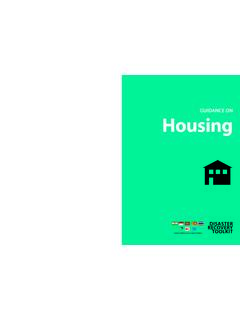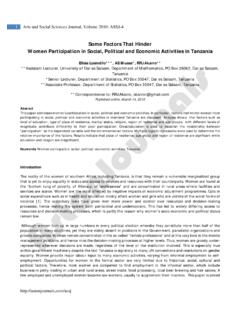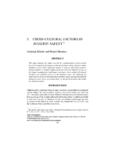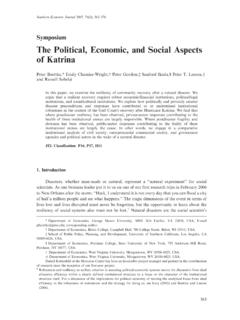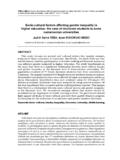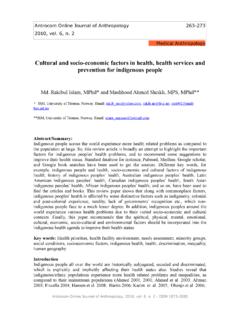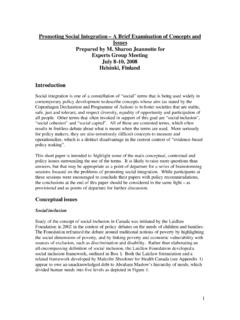Transcription of UNDERSTANDING VULNERABILITIES: II (Social, …
1 Earthquake Vulnerability Reduction for Cities (EVRC-2) Module 3 Session 2(a) 1 UNDERSTANDING vulnerabilities : II ( social , cultural and Economic) Goal To instill an UNDERSTANDING of social , cultural and economic vulnerabilities to earthquakes Learning outcome After completing this session, you will be able to describe and discuss social , cultural and economic vulnerabilities in the context of societies in developing countries with special focus on Asian country situations Learning objectives As you work through this session you will learn to Explain what social vulnerability is and its determinant factors Identify vulnerable groups and provide their profile for training based on the need assessment Explain the historical perspectives of marginalized sectors in society and their vulnerability status Relate the model of disaster cycle to developing country situations and discuss its relevance to earthquake disasters and social vulnerability Discuss poverty and its role in creating vulnerability Explain cultural
2 Vulnerability Explain economic vulnerability 1. Some Basic Issues Earthquake affects not only the built environment, but everything Earthquakes affect everyone and everything in a community. It is not only that the buildings are damaged or destroyed and infrastructure is rendered in-operational. Like every other natural hazard, earthquake can destroy centers of economic, cultural and social activities. In such case, a devastating earthquake disturbs the economic, cultural or social , aspects of communities. But there is something more to this. By destroying the individual buildings, critical facilities, or economic of cultural centers, earthquake of any natural hazard disturbs or destroys the existing interrelationship and interaction between or among the different Keywords/phrases social vulnerability Vulnerable groups Determinants of vulnerability Demographic social stratification Literacy Family type Cohesion among neighbors social resilience cultural vulnerability Economic vulnerability Earthquake Vulnerability Reduction for Cities (EVRC-2) Module 3 Session 2(a) 2 groups and activities of the society or a nation.
3 Such relationships and interdependence are established in any society on the long term. These relationships and interdependence are dynamic, and it is the responsibility of social organizations to guide the dynamics of such relationships in a progressive direction. This is especially important in developing countries. The susceptibility of any community or nation to be affected by an earthquake in terms of the disruption to political, economic and cultural relationship or interdependency among the different social constituencies, and the inability to restore these interdependencies to the pre-earthquake levels can be termed the social vulnerability to earthquakes. History has shown that nations with such vulnerabilities have seen changes in government or its governing system following a disaster.
4 The fall of governments .. (in the past decades) in Ethiopia, Niger, Mauritania, and Chad were associated with allegations of mismanagement of famine, while that in Jamaica and Nicaragua with the mismanagement of hurricane and earthquakes respectively. The Great Tangshan Earthquake of 26 July killed 250,000 people and another 250,000 went missing. This shows the vulnerability of the society. China had to mobilize all possible resources for rescue, and relief operations. This earthquake was the reason why the cultural Revolution came to a halt in China (Shah, 2001). We usually hear that the development process of a country has slipped back due to the impact of several a disaster.
5 This is because of the vulnerability of the country to natural hazards. Years after the earthquake events, countries like Nicaragua, Turkey, and India are grappling to undo the effects of earthquake on development. Earthquake Vulnerability Reduction for Cities (EVRC-2) Module 3 Session 2(a) 3 The Bhuj Earthquake of 26th January in Gujarat badly affected Ahmedabad, located about 250 km away from the epicenter. There was total confusion following the earthquake. Even the news of devastation reached the authorities very late after several hours, because the communication did not functioned effectively. Moreover, the whole administration of Ahmedabad was paralyzed for several days following the earthquake its people listened more to the fortune tellers than to the administration or the scientists.
6 The people slept outside for weeks despite the government s reassurance This happened because of social vulnerabilities : unnecessary fear of death, lack of confidence on the administration and the local scientists, feeling of helplessness, lack of preparedness, and low level of earthquake awareness all contribute to such unwanted situation. In contrast, nothing would have happened if a similar earthquake would have struck California (Shah, 2001). California has much less social vulnerability than Gujarat, although the level of earthquake hazard is much higher. Disasters create further vulnerabilities Ongoing drought condition and the hurricane of the past years rendered the people of Kuch.
7 In India, more vulnerable to the earthquake that hit them in January 2001. The state was geared towards reducing the impacts of drought and cyclonic winds, as reflected in the preparedness embodied in the district level disaster management plan. The earthquake added to the social vulnerabilities created by the past disasters. It deepened the social crisis which became evident recently, when the state was engulfed in a series of crises: ethnic, political, economic and cultural . Nepal is similarly placed in state of increasing vulnerability because of the social conflict and terrorism that is currently on going. Normal concept of disaster cycle does not work fully in case of earthquake disaster in a developing country The normal disaster cycle, prescribed frequently, consists of Mitigation Preparedness Event Rescue/relief reconstruction, as described in a simplified form in the following figure.
8 Earthquake Vulnerability Reduction for Cities (EVRC-2) Module 3 Session 2(a) 4 ` There are two problems with this generic concept of disaster cycle in case of earthquake disasters. Events never follow this cycle in developing countries. The response phase is given the maximum importance. However, it is mostly spontaneous. Not very many countries have emergency response plans. There are problems with relief distribution, and rehabilitation. A larger part of the society at this stage gets thrown out of the disaster cycle. They are not involved in the relief and rehabilitation stage of disaster management. In case of earthquake and flood disasters, many vulnerable communities become internally displaced.
9 Vulnerable sectors of the society gets ejected in each phase of disaster cycle. Some are ignored during reconstruction, and others during mitigation and preparedness. Level of participation of the people in the different phases of disaster cycle could be regarded as the measure of social vulnerability- the larger percentage of people participating; the less vulnerable is a nation Mitigation and Preparedness: Activities to reduce the impact of an earthquake before it strikes, Public awareness activities Implementing seismic building code Strengthening existing structures Planning and training for emergency response activities Earthquake research Emergency Response and Relief: Actions shortly after an earthquake which address the emergency needs of the community, Search and rescue of buried victims Emergency medical care Fire suppression Shelter for homeless victims Distribution of food, water, and supplies Rehabilitation and Reconstruction.
10 The long-term process of rebuilding all aspects of a community following an earthquake, Rebuilding houses and buildings Financing for rebuilding Repair of roads, bridges, water system, etc. Psychological counseling Before an earthquake Long-term after an earthquake 123 Immediately after an earthquake Earthquake Vulnerability Reduction for Cities (EVRC-2) Module 3 Session 2(a) 5 Earthquakes have low annual probability. A devastating earthquake occurs in a country usually after a long interval. The earthquake disaster cycle is very long-term. Society tends to loose forget experiences and lessons learned in previous disasters. Unfavorable conditions such as poverty, rapid population growth, multiple disasters, environmental degradation have much faster disaster cycles.

